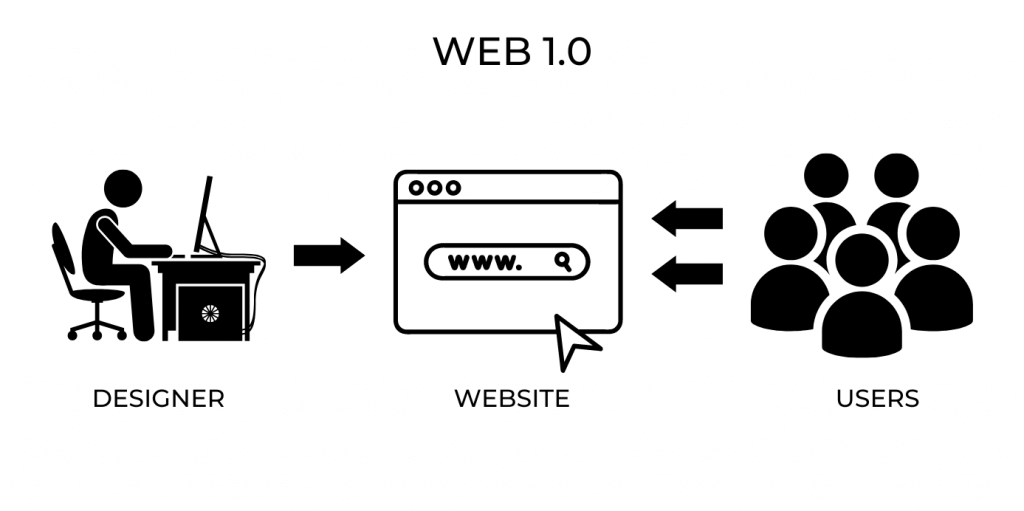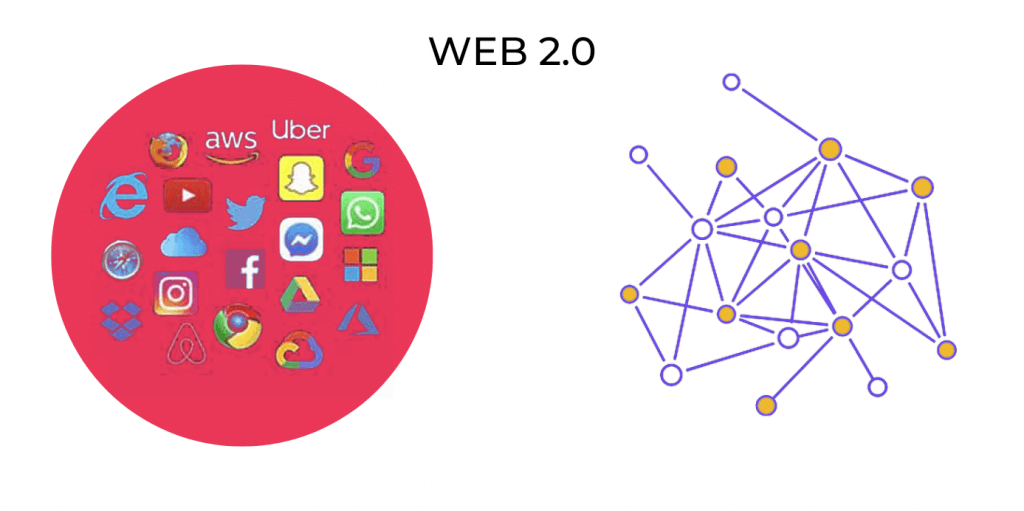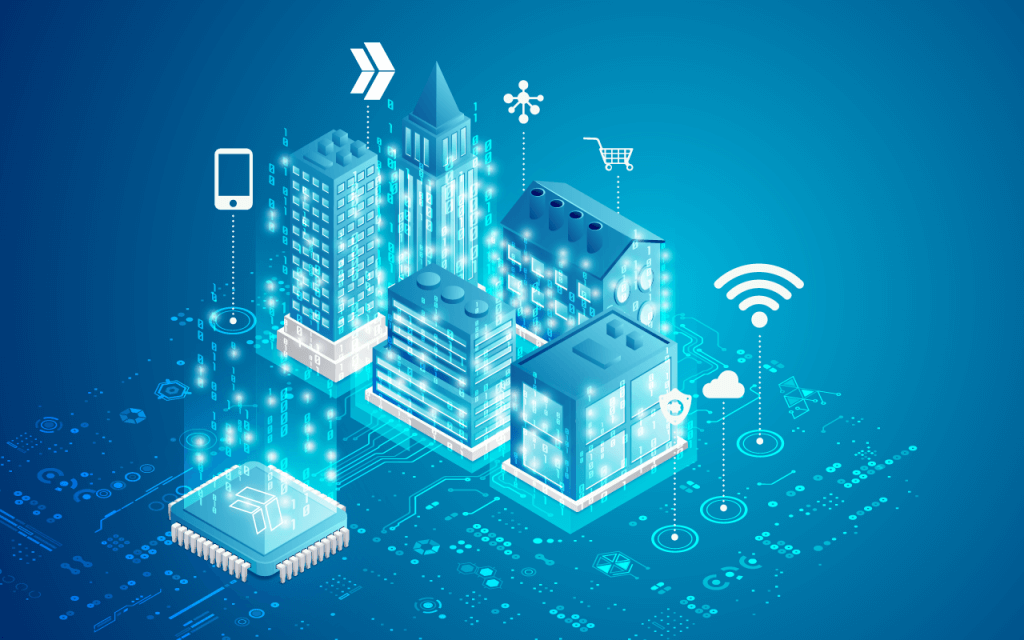We have moved from viewing just static web pages in the 90s to creating social media, and we are currently experiencing another paradigm shift known as Web3. As the world keeps evolving, we need to get up to speed with the trends and benefits of these innovations. In this article, we will see the different versions of the internet and also highlight the web2 web3 difference.
What is Web 1.0?
Between 1991 -2004, the first generation of the internet existed. This version of the internet is known as Web1.0, and it was a read-only web. Web1.0 was mainly used as a stream for information, allowing the broadcast of information on static pages. With Web1.0, users could search for information and just read it, which is why it is referred to as the read-only web.
Unlike what we see today, Web1.0 web pages are joined using hyperlinks with no additional visuals, interactivity, text forms, and control. Web1.0 had very few content creators and lots of content consumers. These readers had no option of interacting with the sites, and there were lots of personal sites.

Features of Web 1.0
Web1.0 is a term created to refer to the stage of the internet before the term Web2.0 was coined by Darcy DiNucci. During the Web1.0 era, websites are the following features;
Static Pages:
Web1.0 has no interactive features on web pages because most pages were built with static HTML pages just to display information.
Website Storage:
To currently store a website’s content, we use databases. During the Web1.0 era, website content was not stored in a separate database but stored directly in the website files.
Website Layout And Combination of Content:
Designing web pages during the Web1.0 era, most styling was done on the HTML page. It was an acceptable web practice at that time, but present web practice requires separating HTML pages from styling pages. In other words, most modern websites use external style sheets to style the web pages.
Web Browsers Support for Proprietary HTML Tags:
Web1.0 browsers offered support for proprietary tags which resulted in incompatibility problems for some websites. Web1.0 browsers did this to stand out from each other. Site visitors had to use a particular browser to visit some websites.
Guestbooks:
Web1.0 pages had a page called “Guestbook Page”. Users’ comments are added to the page rather than the content page.
What is Web 2.0?
The present version of the internet, known as Web2.0, represents a paradigm shift in how the internet is used. The term became famous due to the Web2.0 Summit held in 2004 by Tim O’Reilly and Dale Dougherty. Web2.0 is the internet that we know of today that provides interactivity, user-generated content, and social connectivity for users.
Web2 is the enhanced version of web1.0 as it replaced the dull web pages of web1.0. Web2 is more dynamic, and it transformed how we deliver information by introducing blogs, wikis, and social media platforms.
Mobile internet access, social network, and mobile devices are some innovations that led to the exponential growth of web2.0. Web2.0 developments led to the discovery of applications such as Facebook and Twitter that expanded social interactivity and other utility. Web2.0 made the whole world a small village.
Web2 made it possible for us to see the world differently, it enabled many people to earn income in different ways on a part-time or full-time basis. It made it possible and easier for anyone to sell services online, rent homes, and work from the comfort of their home.
Features of Web 2.0
Web2 is the second generation of Web-based services, and it also fosters online interaction and connectivity among users. Web2 gave rise to the evolution of digital applications. Some of the features of web2.0 are;

Classification of Information
Web2 makes it possible for users to get easier access to information through easier sorting of information. Users can retrieve and classify information.
Better User Experience
Web2 provides a better user experience to users as web2 uses Ajax (Asynchronous JavaScript + XML), and HTML5 to make dynamic and interactive web pages. The technologies employed in web2 replaced traditional modes like SWF Flash media used in web1.0.
User Interaction
The ability of users to interact with the website is one of the significant features of web2.0. Web2 makes it possible for users to contribute content by the addition of review and comment features to web pages. Users can also participate in content sourcing by putting up their content on the website. Web2 provides a platform for user interaction which is an improvement to web1, which provides static pages.
A good example is content-sharing platforms like YouTube and Vimeo.
What is Web 3.0?
Let’s take a look at ”What is Web3?” Web3 is the version of the internet after web2, an upgrade to its precursors: web1.0 and web2.0. It is the evolution of the internet that caused a paradigm shift just the same way web2 did. Web3 is a word coined by Ethereum co-founder Gavin Wood. Web3 will use blockchain technology, cryptocurrencies, and NFTs to make web users experience more control of the data and activities on the internet.
Web3 is a blockchain-based internet that will improve the way we use the internet currently. Web3, also known as Semantic web, will be an enhanced version of web2 where Artificial Intelligence and Machine Learning will make computers interpret information like humans.
One major difference between web2 and web3 is how Web3 will improve on the flaws of web2 by allowing web users to monetize their activity and contributions to a platform. Presently, social media users do not get paid to use these social media platforms, but a social media platform built on web3 will make it possible for users to earn while using its platform.
Another flaw associated with Web2 is data privacy, as big Tech companies are in total control of a user’s data gotten from sign-ups or surveys etc. Data ownership is another difference between web2.0 and web3.0. Web3 will put users in charge of their data by ending incessant signup with innovations like the Domain Naming service, where identities will be tied to a Web3 wallet address.

Features of Web 3.0
Web3 enhances the internet as we know it today and to understand web3, we need to know some of the features of Web3.0:
Semantic Web
According to Berners-Lee, the Semantic Web allows computers to analyze data from the web in a different form by allowing the computer to decode meaning and emotions. This will allow internet users to enjoy a better user experience through enhanced data connectivity.
Decentralization
Decentralization is one of the fundamental features of web3.0. Ownership and governance will be distributed among its users rather than giving control to a small group of people as with web2 platforms.
Decentralization will be possible because information on web3 will be stored in multiple locations, so internet giants will not have access to the database. Users will retain data ownership by selling data generated by powerful computing resources, technology companies, and appliances through decentralized data networks.
Universality
Since web3 is an enhanced version of web2 and web2 is already popular worldwide. Web3 will take the internet a step further by making the internet accessible to everyone. We would see different web2 platforms switching to incorporate web3 services on their platform. IoT (Internet of Things) will bring forth new types of smart devices, and concentration will shift from using internet-connected devices on smartphones and computers.
Trustless and Permissionless
Web3 will provide a trustless network in the sense that it will not require the presence of a third party before participants can interact. Also, a permissionless network that does not require participants to receive authorization from a governing body. This feature makes Web3 an ideal network where decentralized services are built. An example is decentralized finance (Defi).
Difference Between Web2 and Web3
The difference between web1, web2, and web3 signifies how far we have come as humans. The Web2 web3 difference table will highlight the difference between both versions.
| Web2 | Web3 |
|---|---|
| Community development and Interaction are the focus. | Decentralization, semantic learning, and giving more control to users are the focus. |
| Social media can censor accounts. | There can be no form of censoring due to decentralization. |
| The Network has control over data. | Users have control over data. |
| HTML, CSS3, and JavaScript are some of the technologies used. | Machine Learning, Artificial Intelligence, and decentralized protocols are used in Web3. |
| Payment services are centralized. | Decentralized Payment services. |
Which One is Better Web 2.0 Vs. Web 3.0?
We cannot underestimate the benefits of these two versions of the internet. We have seen and experienced an easier way of doing things using web2.0 and web3.0 platforms. Web2 vs web3 is a discussion where critics rate one version over the other but Web 2 vs Web 3 argument will highlight how both versions will improve how we use the internet. To shed more light on the web2 web3 difference and web 3.0 vs 2.0 argument, we would consider the relevance of both versions.
Considering Web2.0
Web2.0 brought dynamic content and interactivity to the internet due to technologies like HTML, CSS, and JavaScript. These technologies have led to the creation of different applications that we all use today.
Social media, blogging, and podcasting are interaction-based, and they have made communication and information dissemination easier for everyone. People can engage each other through comments and messages easily. Web2 brought about the popularity of Facebook, Google, and Twitter.
Considering Web3.0
Web3 is an advanced version of Web2, and it uses new technologies like AI to know content semantics on the web. Artificial Intelligence makes it easier for users to find, merge and share information easily as machines can understand and interpret data like humans.
Decentralization and permissionless systems which are the core features of Web3, will give users more control over their data.
We can deduce that the “web 2.0 vs 3.0” argument proves that the technological advancement in Web3 does not mean the internet will have a different look, but it will complement the flaws we see in web2. Therefore, we should see an increase in decentralized versions of Web2 applications that we use now without too many visual differences.
Conclusion
Customized browsing experience, human-like search assistance, and decentralization are some of the benefits the new version of the internet will provide. Web3 is still in its infancy stage, and it will make the internet more integrated into our daily lives. We can also see that the web2 web3 difference comes to who controls or owns data and content.
Aside from the benefits, it will provide users with career opportunities abound as many people will switch careers to enjoy its lucrative job opportunities. There are so many job opportunities like Blockchain development and web3.0, Cloud Engineering, Data Science, Salesforce, and Cyber security.
One of the best and most reliable methods of getting this knowledge, as advised by experienced people in the field, is attending IT bootcamps. Clarusway provides the perfect boot camp that teaches everything about learning web3 and also other services to make every student succeed in their learning and post-learning journey.




